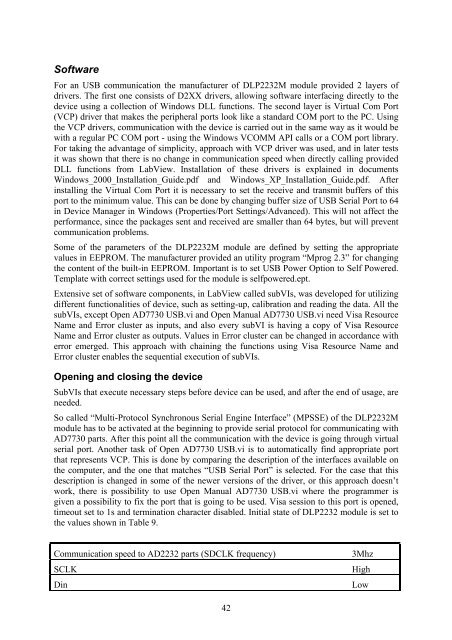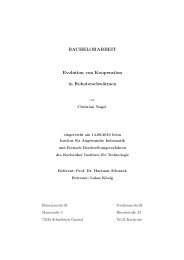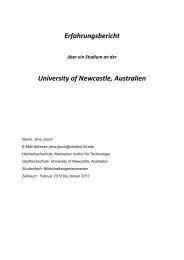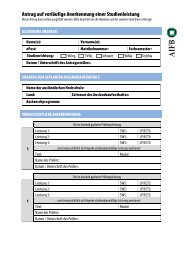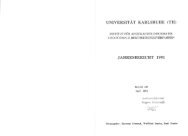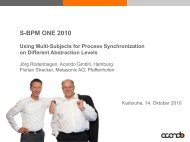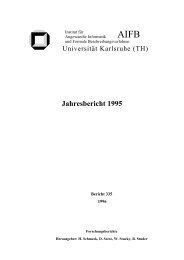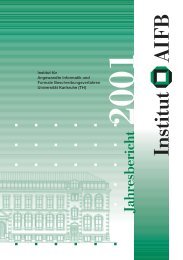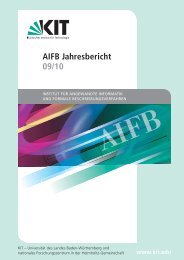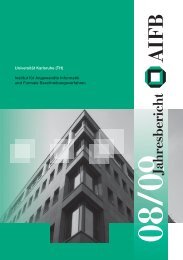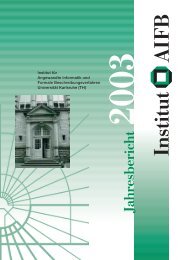Design and Implementation of HW-SW System for ... - Institut AIFB
Design and Implementation of HW-SW System for ... - Institut AIFB
Design and Implementation of HW-SW System for ... - Institut AIFB
Create successful ePaper yourself
Turn your PDF publications into a flip-book with our unique Google optimized e-Paper software.
S<strong>of</strong>tware<br />
For an USB communication the manufacturer <strong>of</strong> DLP2232M module provided 2 layers <strong>of</strong><br />
drivers. The first one consists <strong>of</strong> D2XX drivers, allowing s<strong>of</strong>tware interfacing directly to the<br />
device using a collection <strong>of</strong> Windows DLL functions. The second layer is Virtual Com Port<br />
(VCP) driver that makes the peripheral ports look like a st<strong>and</strong>ard COM port to the PC. Using<br />
the VCP drivers, communication with the device is carried out in the same way as it would be<br />
with a regular PC COM port - using the Windows VCOMM API calls or a COM port library.<br />
For taking the advantage <strong>of</strong> simplicity, approach with VCP driver was used, <strong>and</strong> in later tests<br />
it was shown that there is no change in communication speed when directly calling provided<br />
DLL functions from LabView. Installation <strong>of</strong> these drivers is explained in documents<br />
Windows_2000_Installation_Guide.pdf <strong>and</strong> Windows_XP_Installation_Guide.pdf. After<br />
installing the Virtual Com Port it is necessary to set the receive <strong>and</strong> transmit buffers <strong>of</strong> this<br />
port to the minimum value. This can be done by changing buffer size <strong>of</strong> USB Serial Port to 64<br />
in Device Manager in Windows (Properties/Port Settings/Advanced). This will not affect the<br />
per<strong>for</strong>mance, since the packages sent <strong>and</strong> received are smaller than 64 bytes, but will prevent<br />
communication problems.<br />
Some <strong>of</strong> the parameters <strong>of</strong> the DLP2232M module are defined by setting the appropriate<br />
values in EEPROM. The manufacturer provided an utility program “Mprog 2.3” <strong>for</strong> changing<br />
the content <strong>of</strong> the built-in EEPROM. Important is to set USB Power Option to Self Powered.<br />
Template with correct settings used <strong>for</strong> the module is selfpowered.ept.<br />
Extensive set <strong>of</strong> s<strong>of</strong>tware components, in LabView called subVIs, was developed <strong>for</strong> utilizing<br />
different functionalities <strong>of</strong> device, such as setting-up, calibration <strong>and</strong> reading the data. All the<br />
subVIs, except Open AD7730 USB.vi <strong>and</strong> Open Manual AD7730 USB.vi need Visa Resource<br />
Name <strong>and</strong> Error cluster as inputs, <strong>and</strong> also every subVI is having a copy <strong>of</strong> Visa Resource<br />
Name <strong>and</strong> Error cluster as outputs. Values in Error cluster can be changed in accordance with<br />
error emerged. This approach with chaining the functions using Visa Resource Name <strong>and</strong><br />
Error cluster enables the sequential execution <strong>of</strong> subVIs.<br />
Opening <strong>and</strong> closing the device<br />
SubVIs that execute necessary steps be<strong>for</strong>e device can be used, <strong>and</strong> after the end <strong>of</strong> usage, are<br />
needed.<br />
So called “Multi-Protocol Synchronous Serial Engine Interface” (MPSSE) <strong>of</strong> the DLP2232M<br />
module has to be activated at the beginning to provide serial protocol <strong>for</strong> communicating with<br />
AD7730 parts. After this point all the communication with the device is going through virtual<br />
serial port. Another task <strong>of</strong> Open AD7730 USB.vi is to automatically find appropriate port<br />
that represents VCP. This is done by comparing the description <strong>of</strong> the interfaces available on<br />
the computer, <strong>and</strong> the one that matches “USB Serial Port” is selected. For the case that this<br />
description is changed in some <strong>of</strong> the newer versions <strong>of</strong> the driver, or this approach doesn’t<br />
work, there is possibility to use Open Manual AD7730 USB.vi where the programmer is<br />
given a possibility to fix the port that is going to be used. Visa session to this port is opened,<br />
timeout set to 1s <strong>and</strong> termination character disabled. Initial state <strong>of</strong> DLP2232 module is set to<br />
the values shown in Table 9.<br />
Communication speed to AD2232 parts (SDCLK frequency) 3Mhz<br />
SCLK High<br />
Din Low<br />
42


